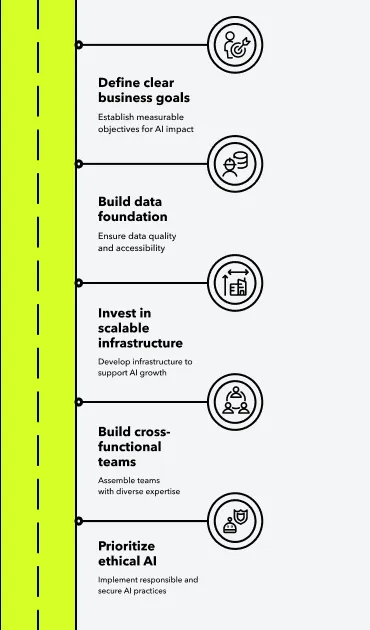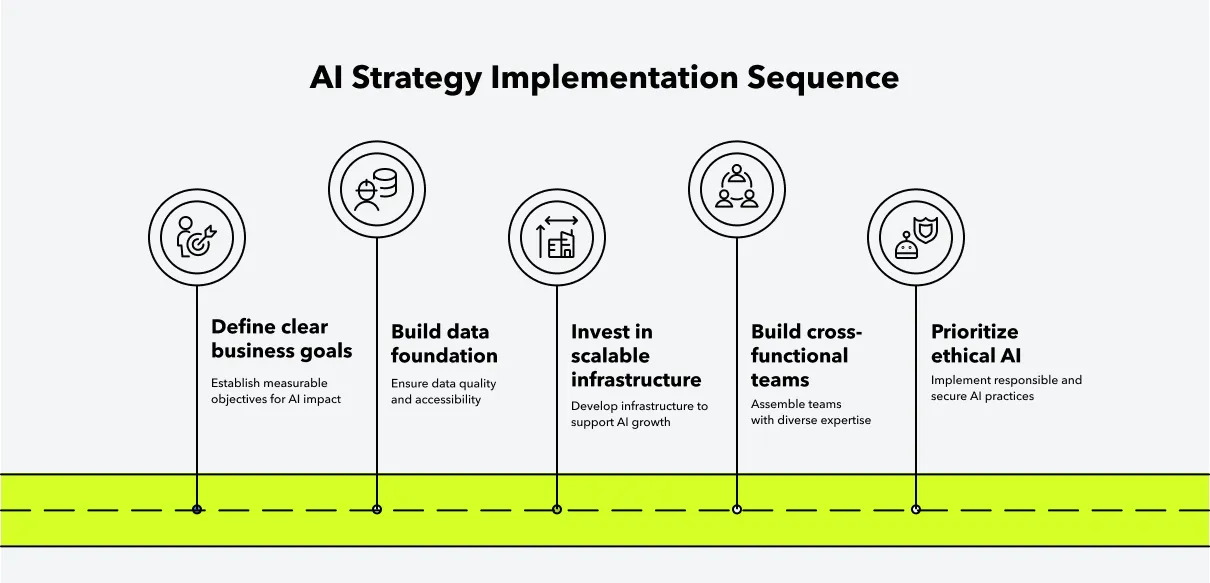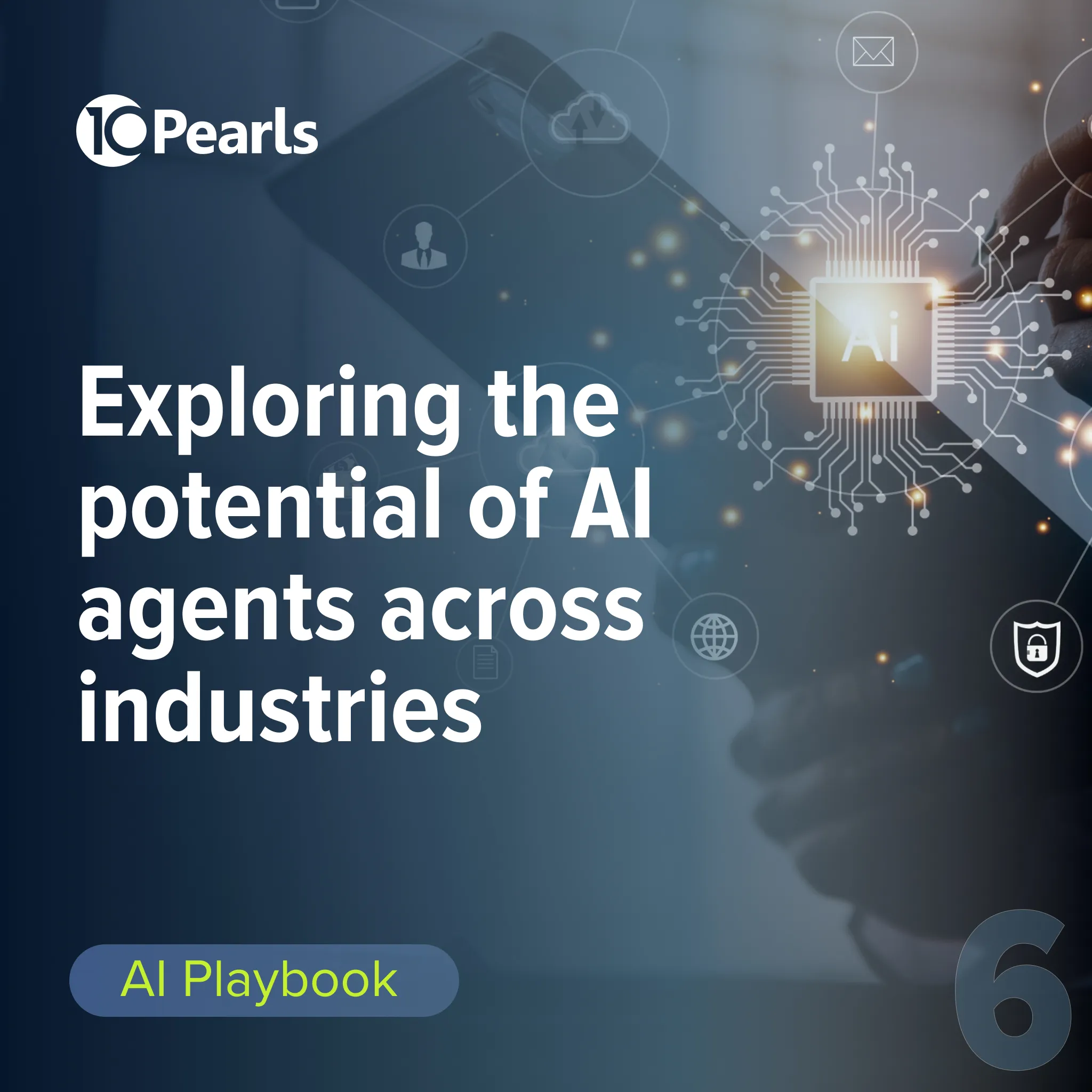AI Strategy for Business Impact – Proven Steps to Maximize ROI
By 10Pearls editorial team
A global team of technologists, strategists, and creatives dedicated to delivering the forefront of innovation. Stay informed with our latest updates and trends in artificial intelligence, advanced technology, healthcare, fintech, and beyond. Discover insightful perspectives that shape the future of industries worldwide.
As organizations eagerly launch AI initiatives to strengthen their competitive edge, many are finding that their efforts are falling short of delivering meaningful value. Through our work helping enterprises as a digital transformation and AI implementation partner, we’ve noticed a common pattern in organizations adopting AI: lack of clarity and strategic alignment in the planning process.
Effective AI strategies aren’t built around technology – they’re designed to address and target specific business challenges. This blog will outline common pitfalls in AI implementation and strategies to help you ensure your organization sees measurable impact from your AI initiative. Whether you’re just beginning your AI journey or looking to align existing initiatives to your business needs, we’ll help you move forward with confidence.

Common pitfalls in AI implementation
Not prioritizing use cases
Whether it’s AI or another emerging technology, organizations often feel inclined to pursue AI use cases based on technological interest rather than business impact. This typically results in a broad project scope, misaligned expectations, and models that have technical promise but fail to solve any real problem.
Misalignment with business goals
AI initiatives can fall flat if they aren’t aligned with broader business goals. Misaligned AI initiatives often fail to drive meaningful outcomes, resulting in minimal impact on revenue and operational targets.
Ignoring scalability
Failing to plan for scalability is a critical oversight that can hurt your AI success in the long run. Many organizations launch pilots with rigid, siloed systems that aren’t built to handle increased data volumes or evolving business needs. This leads to costly rework down the line.
Building an AI strategy that drives measurable ROI
To develop a successful AI strategy, you must have a structured approach that aligns AI capabilities with business objectives. Here are key pillars that can help you maximize AI impact while mitigating the common pitfalls that can derail AI initiatives.


1. Define clear, measurable business goals
Successful AI implementation starts with a clear by understanding of the business challenges you’re aiming to solve. Starting with a business-first approach transforms AI from a technological experiment into a strategic tool with a direct impact on organizational performance and competitive positioning.
Business goals allow you to define metrics that guide your AI strategy, helping you make decisions and track progress throughout implementation. By having clear, measurable KPIs, such as customer satisfaction scores, operational efficiency gains, or revenue growth targets—organizations create accountability and ensure AI investments deliver tangible returns that drive business growth.
2. Start with the right data foundation
Businesses often underestimate the importance of data readiness, rushing to implement AI models before establishing a solid data infrastructure. The first step is evaluating the current state of data infrastructure.
To do this, assess data quality, data accessibility, and how relevant the available data is to your AI model and use case. Depending on your findings, you might need to make improvements to establish clear protocols for data collection, usage, retention, and protection—not just to satisfy regulatory requirements, but to build a trustworthy database that your AI model and users can rely on. Taking these steps to ensure your data is accurate, relevant, and well-governed will lay a strong foundation to ensure your AI initiative is effective and scalable.
3. Invest in scalable infrastructure
Building an AI model that can scale demands a strong, dynamic infrastructure. Scalable infrastructure, such as cloud-based platforms, allows AI solutions to grow seamlessly, supporting future expansion without disrupting operations. Developing your model with scalability in mind from the start helps you reduce long-term rework costs, maintain agility, and position your organization to adapt to new opportunities.
4. Build cross-functional AI teams
Teams that combine diverse expertise, from data scientists and engineers to domain specialists and business analysts, develop more comprehensive and effective solutions that address both technical and practical requirements.
Your ideal AI team should maintain continuous dialogue between technical practitioners and business stakeholders, ensuring solutions remain aligned with evolving organizational priorities. Regular touchpoints for progress review, feedback collection, and direction adjustment help prevent the common scenario where AI projects drift toward technical perfection but away from business relevance.
5. Prioritize responsible and ethical AI
Responsible and secure AI practices are critical in all industries but especially in sectors that are highly regulated. Organizations that proactively address issues of transparency, fairness, and explainability position themselves ahead of their competitors who deal with these issues afterthoughts.
As AI applications increasingly touch sensitive operational areas and customer interactions, privacy and security considerations become paramount to implementation success. Organizations must establish responsible AI practices by having cross-functional stakeholders that include representatives from legal, compliance, IT, and business to oversee AI initiatives and ensure alignment with organizational values.
- Conduct regular AI audits to assess algorithms for bias and fairness
- Establish clear data governance policies defining data usage and access rights
- Create transparency standards that document AI decision-making processes with maintainable audit trails
- Develop employee training programs on ethical AI principles, partner with external experts for independent system assessments, and establish incident response procedures for unexpected AI outcomes
- Regular stakeholder engagement, including customer feedback mechanisms, helps identify potential ethical concerns early in development
By embedding these practices into standard operating procedures rather than treating them as afterthoughts, organizations build sustainable frameworks that reduce compliance risk and protect brand trust.
How 10Pearls helps organizations maximize AI impact
We understand that successful AI implementation requires more than technical expertise; it demands a comprehensive approach that connects technology capabilities with business strategy. Our process starts with by understanding your unique challenges and objectives to ensure every AI solution we develop addresses specific business needs rather than simply showcasing a new tech capability.
Our team brings deep expertise across the AI ecosystem from machine learning and natural language processing to computer vision and predictive analytics coupled with practical experience implementing these technologies in real-world business environments.
This combination of technical knowledge and implementation experience helps organizations navigate the complexity of AI adoption and accelerates time-to-value. We work alongside your team to transfer knowledge throughout the implementation process, building internal capabilities that support long-term AI success.
Get in touch with us
Related articles







